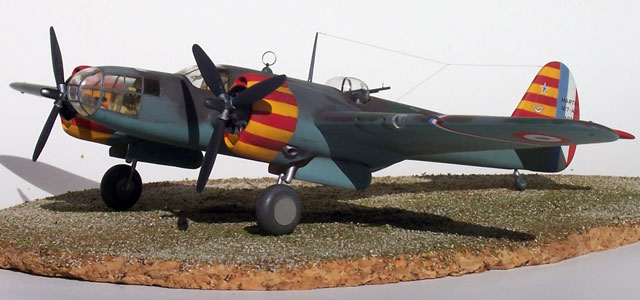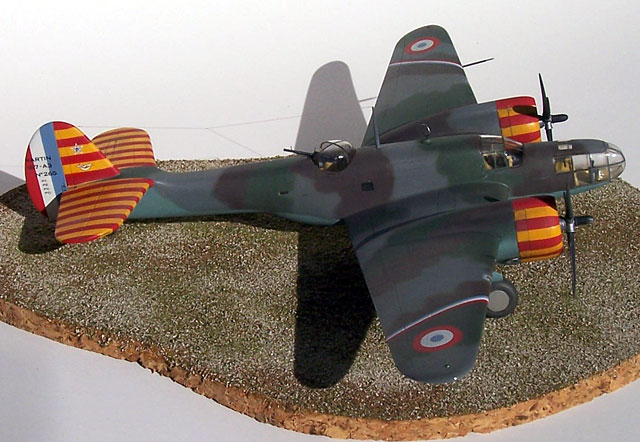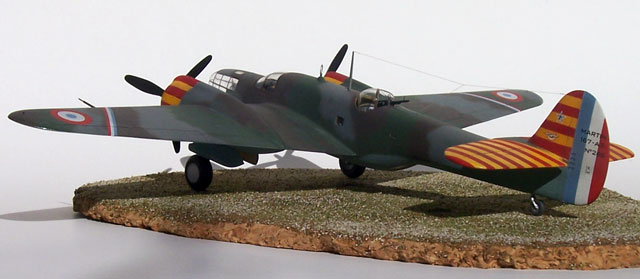|
1/72 scale Azur
Martin 167
Maryland
by Mark Davies
|
 |
|
Martin Model 167 Maryland |

Azur's
1/72 scale Martin Maryland is available online from
Squadron
Background
The Martin Model 167 was a response to a 1938 USAAC request for a
twin engine light attack aircraft. Other designs pit forward for th e
same requirement later developed into the Douglas A-20 and the North
American B-25. Martin’s 167 never saw front line service with the
Americans, but it did go to war in service with the French and British.
In French service, it was know as “Glenn”, and was used by both the
Armée de l’Air and Aéronavale. Surviving machines were relocated to
North Africa following the fall of France under the Vichy regime.
Regrettably no Maryland survives today.
Azur's 1/72 scale Maryland
This is the sixth Azur kit I have built, and is one of 26 that I have
bought so far.
Azur’s Maryland is a welcome improvement on the old Frog kit in 1:72.
It’s generally well detailed for the scale and has very fine engraved
panel lines. The props, exhausts, pitot, aerial mast and DF loop are
resin, with everything else moulded in styrene including the canopies.
There is a choice of RAF desert of Vichy French schemes. No points for
guessing which one I chose! This kit is representative of about mid-life
in terms of Azur releases: better than their Breda Ba 65, but not as
good as their Potez 63-11.
The kit only really on suffers from a couple of faults; these being the
wrong engines (Wright 9-cylinder R1820’s instead of P&W 14-cylinder
R1830’s), and very shallow inlets on the top and bottom of the cowl
faces. Less serious is the need to cut a couple of windows into each
side of the fuselage.
I spent most of my time Dremelling out the intakes at the top and
bottom of the cowl faces. On the kit these are only moulded in relief of
about 0.5mm, and fail to do justice to what I feel is a significant
feature of the Maryland. This was followed by more Dremelling to get
some resin copies of the Academy PBY Catalina’s R1830 engines to fit
(these came courtesy of a friend).

Other additions and modifications included adding a belly gun,
detailing the turret gun a bit, adding some etched seat belts, and two
windows to the fuselage sides, wing guns and one or two items within the
nose transparency area. I found the very clear canopies to be a little
undersize, but better dry assembling would have led me to reduce the
fuselage width before joining the halves. As a result I sanded all the
moulded framing off them and replaced them using decal film.
Painting was fairly straightforward, with the striped areas being
painted over a white undercoat. Masking the cowls and was a little
fiddly to get the stripes tapering the right way. All camouflage was
quickly free-handed as photos suggest quite a soft edge.
The final model was weathered a bit with chips, scratches and stains,
although looking at the photos I feel the props are too dark and I will
attend to these at some time in the future.

I’m happy enough with the final result as cabinet display model, and
recommend the kit to anyone who fancies something a little different.
Click the thumbnails
below to view larger images:
Images and Text Copyright ©
2005 by Mark Davies
Page Created 17 August, 2005
Last Updated
16 August, 2005
Back to
HyperScale Main Page |
Home
| What's New |
Features |
Gallery |
Reviews |
Reference |
Forum |
Search